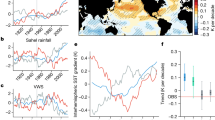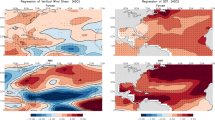Abstract
Increasing sea surface temperatures in the tropical Atlantic Ocean and measures of Atlantic hurricane activity have been reported to be strongly correlated since at least 1950 (refs 1, 2, 3, 4, 5), raising concerns that future greenhouse-gas-induced warming6 could lead to pronounced increases in hurricane activity. Models that explicitly simulate hurricanes are needed to study the influence of warming ocean temperatures on Atlantic hurricane activity, complementing empirical approaches. Our regional climate model of the Atlantic basin reproduces the observed rise in hurricane counts between 1980 and 2006, along with much of the interannual variability, when forced with observed sea surface temperatures and atmospheric conditions7. Here we assess, in our model system7, the changes in large-scale climate that are projected to occur by the end of the twenty-first century by an ensemble of global climate models8, and find that Atlantic hurricane and tropical storm frequencies are reduced. At the same time, near-storm rainfall rates increase substantially. Our results do not support the notion of large increasing trends in either tropical storm or hurricane frequency driven by increases in atmospheric greenhouse-gas concentrations.
This is a preview of subscription content, access via your institution
Access options
Subscribe to this journal
Receive 12 print issues and online access
$259.00 per year
only $21.58 per issue
Buy this article
- Purchase on Springer Link
- Instant access to full article PDF
Prices may be subject to local taxes which are calculated during checkout




Similar content being viewed by others
References
Emanuel, K. A. Increasing destructiveness of tropical cyclones over the past 30 years. Nature 436, 686–688 (2005).
Webster, P. J., Holland, G. J., Curry, J. A. & Chang, H.-R. Changes in tropical cyclone number, duration, and intensity in a warming environment. Science 309, 1844–1846 (2005).
Mann, M. & Emanuel, K. Atlantic hurricane trends linked to climate change. Eos 87, 233–241 (2006).
Emanuel, K. Environmental factors affecting tropical cyclone power dissipation. J. Clim. 20, 5497–5509 (2007).
Holland, G. J. & Webster, P. J. Heightened tropical cyclone activity in the North Atlantic: natural variability or climate trend? Phil. Trans. R. Soc. A, doi:10.1098/rsta.2007.2083 (2007).
Climate Change 2007: The Physical Science Basis—Contribution of Working Group I to the Fourth Assessment Report of the Intergovernmental Panel on Climate Change (eds Solomon, S. et al.) (Cambridge Univ. Press, Cambridge, 2007).
Knutson, T. R., Sirutis, J. J., Garner, S. T., Held, I. M. & Tuleya, R. E. Simulation of the recent multidecadal increase of Atlantic hurricane activity using an 18-km-grid regional model. Bull. Am. Meteorol. Soc. 88, 1549–1565 (2007).
Meehl, G. A. et al. The WCRP CMIP3 multimodel dataset: A new era in climate change research. Bull. Am. Meteorol. Soc. 88, 1383–1394 (2007).
Knutson, T. R. et al. Assessment of twentieth-century regional surface temperature trends using the GFDL CM2 coupled models. J. Clim. 19, 1624–1651 (2006).
Santer, B. D. et al. Forced and unforced ocean temperature changes in Atlantic and Pacific tropical cyclogenesis regions. Proc. Natl Acad. Sci. 103, 13905–13910 (2006).
Landsea, C. W. Hurricanes and global warming. Nature 438, doi:10.1038/nature04477 (2005).
Landsea, C. W. Counting Atlantic tropical cyclones back to 1900. Eos 88, 197, 202 (2007).
Chang, E. K. M. & Guo, Y. Is the number of North Atlantic tropical cyclones significantly underestimated prior to the availability of satellite observations? Geophys. Res. Lett. 34, L14801 (2007).
Mann, M. E., Sabbatelli, T. A. & Neu, U. Evidence for a modest undercount bias in early historical Atlantic tropical cyclone counts. Geophys. Res. Lett. 34, L22707 (2007).
Vecchi, G. A. & Knutson, T. R. On estimates of historical North Atlantic tropical cyclone activity. J. Clim. (2008, in the press).
Kalnay, E. et al. The NCEP/NCAR 40-year reanalysis project. Bull. Am. Meteorol. Soc. 77, 437–477 (1996).
Vecchi, G. A. & Soden, B. J. Increased tropical Atlantic wind shear in model projections of global warming. Geophys. Res. Lett. 34, L08702 (2007).
Emanuel, K. A. The dependence of hurricane intensity on climate. Nature 326, 483–485 (1987).
Knutson, T. R., Tuleya, R. E., Shen, W. & Ginis, I. Impact of CO2-induced warming on hurricane intensities as simulated in a hurricane model with ocean coupling. J. Clim. 14, 2458–2468 (2001).
Knutson, T. R. & Tuleya, R. E. Impact of CO2-induced warming on simulated hurricane intensity and precipitation: Sensitivity to the choice of climate model and convective parameterization. J. Clim. 17, 3477–3495 (2004).
Bengtsson, L. et al. How may tropical cyclones change in a warmer climate. Tellus A 59, 539–561 (2007).
Knutson, T. R. & Tuleya, R. E. in Climate Extremes Society (eds Diaz, H. & Murnane, R.) (Cambridge Univ. Press, New York, in the press).
Lonfat, M., Marks, F. D. Jr & Chen, S. S. Precipitation distribution in tropical cyclones using the Tropical Rainfall Measuring Mission (TRMM) microwave imager: A global perspective. Mon. Weath. Rev. 132, 1645–1660 (2004).
Emanuel, K., Sundararajan, R. & Williams, J. Hurricanes and global warming: Results from downscaling IPCC AR4 simulations. Bull. Am. Meteorol. Soc. 89, 347–367.
Zhang, R. & Delworth, T. L. Impact of Atlantic multidecadal oscillations on India/Sahel rainfall and Atlantic hurricanes. Geophys. Res. Lett. 33, L17712 (2006).
Latif, M., Keenlyside, N. & Bader, J. Tropical sea surface temperature, vertical wind shear, and hurricane development. Geophys. Res. Lett. 34, L01710 (2007).
Shen, W., Tuleya, R.E. & Ginis, I. A sensitivity study of the thermodynamic environment on GFDL model hurricane intensity: Implications for global warming. J. Clim. 13, 109–121 (2000).
Tang, B. H. & Neelin, J. D. ENSO Influence on Atlantic hurricanes via tropospheric warming. Geophys. Res. Lett. 31, L24204 (2004).
Vecchi, G. A. & Soden, B. J. Effect of remote sea surface temperature change on tropical cyclone potential intensity. Nature 450, 1066–1070 (2007).
Swanson, K. Nonlocality of Atlantic tropical cyclone intensities. Geochem. Geophys. Geosys. 9, Q04V01 (2008).
Acknowledgements
We thank the WCRP CMIP3 modelling groups for contributing their model runs, and PCMDI and the IPCC Data Archive at LLNL/DOE for providing ready access to the model data. We thank I. Orlanski, B. Gross, O. Pauluis, S. Malyshev, C. Kerr and A. Leetmaa for advice and assistance. This work was partially supported by NOAA/OGP and the NASA Columbia Supercomputing Project.
Author information
Authors and Affiliations
Corresponding author
Supplementary information
Supplementary Information
Supplementary figures S1-S7 (PDF 4808 kb)
Supplementary Information
Supplementary video S2 (MPG 19789 kb)
Supplementary Information
Supplementary video S3 (MPG 10912 kb)
Supplementary Information
Supplementary video S4 (MPG 7540 kb)
Rights and permissions
About this article
Cite this article
Knutson, T., Sirutis, J., Garner, S. et al. Simulated reduction in Atlantic hurricane frequency under twenty-first-century warming conditions. Nature Geosci 1, 359–364 (2008). https://doi.org/10.1038/ngeo202
Received:
Accepted:
Published:
Issue Date:
DOI: https://doi.org/10.1038/ngeo202
This article is cited by
-
Resilience of renewable power systems under climate risks
Nature Reviews Electrical Engineering (2024)
-
Strengthening cold wakes lead to decreasing trend of tropical cyclone rainfall rates relative to background environmental rainfall rates
npj Climate and Atmospheric Science (2023)
-
Tropical cyclones over the South China Sea suppress the monsoonal rainfall in southern China
npj Climate and Atmospheric Science (2023)
-
A Model of the Sea–Land Transition of the Mean Wind Profile in the Tropical Cyclone Boundary Layer Considering Climate Changes
International Journal of Disaster Risk Science (2023)
-
Impact of changes in sea surface temperature due to climate change on hurricane wind and storm surge hazards across US Atlantic and Gulf coast regions
SN Applied Sciences (2023)



